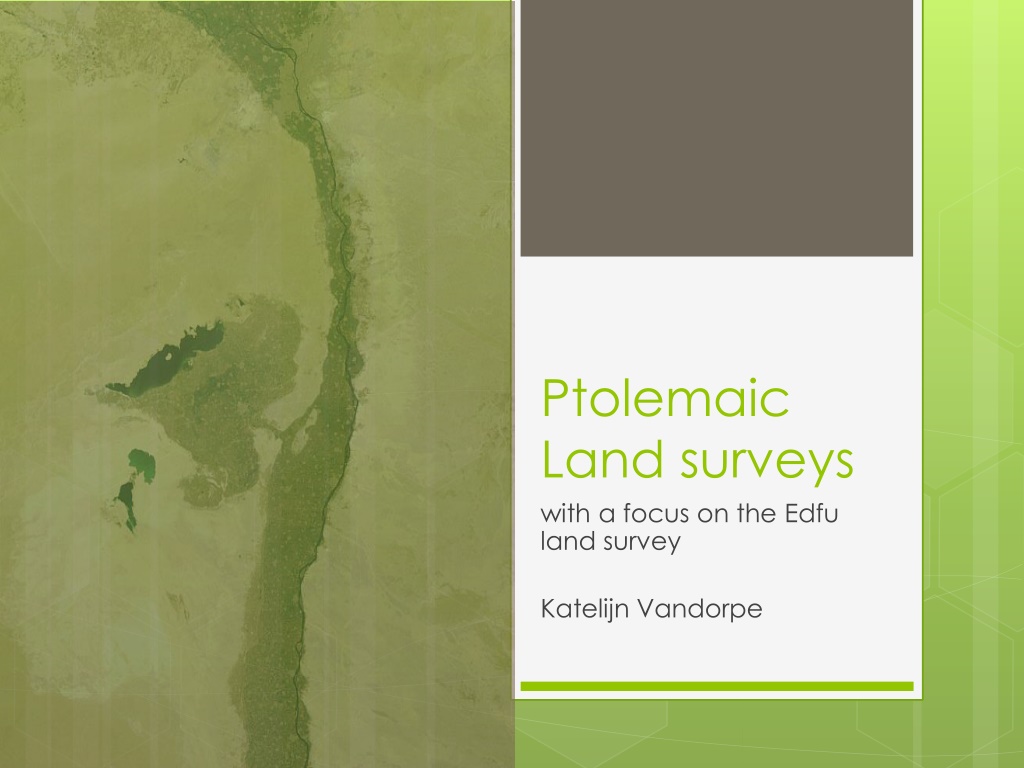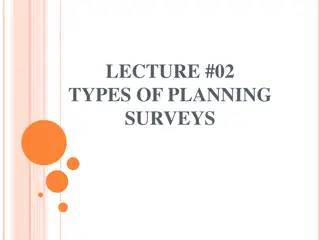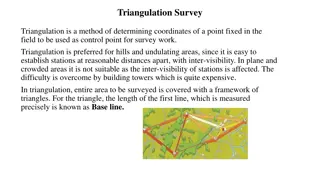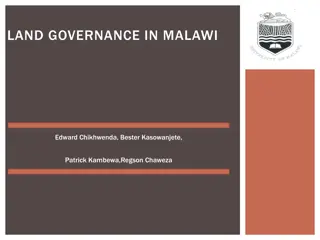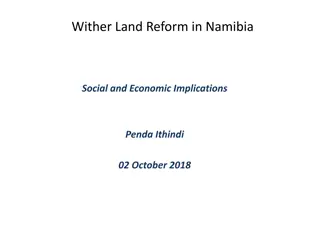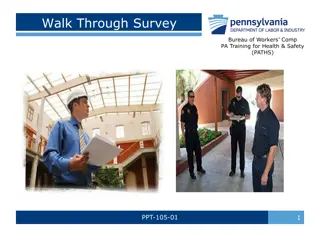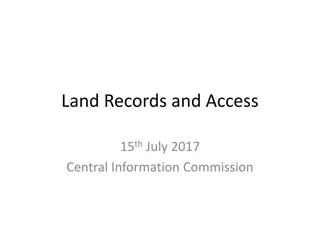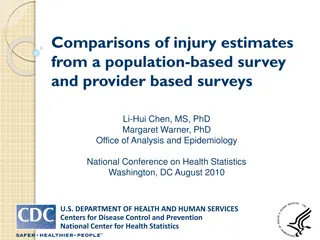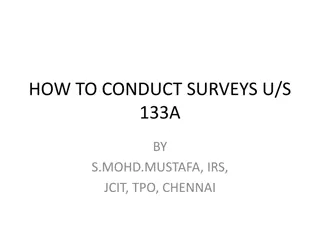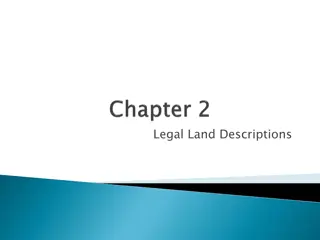Ptolemaic Land Surveys: Insights from Edfu Survey and Related Operations
Explore the intricacies of Ptolemaic land surveys, with a focus on the Edfu land survey conducted by Katelijn Vandorpe. Delve into main survey operations such as cadastral surveys and crop reports, discuss nome surveys at village levels, and analyze topographical land surveys highlighting personal details and crop information. Discover the additional information provided by village scribes during spring meetings and immerse yourself in the meticulous process of documenting land details in ancient times.
Download Presentation

Please find below an Image/Link to download the presentation.
The content on the website is provided AS IS for your information and personal use only. It may not be sold, licensed, or shared on other websites without obtaining consent from the author. Download presentation by click this link. If you encounter any issues during the download, it is possible that the publisher has removed the file from their server.
E N D
Presentation Transcript
Ptolemaic Land surveys with a focus on the Edfu land survey Katelijn Vandorpe
1 ? 8 ? P. Haun. inv. 407, Papyrus Carlsberg Collection of the Univ. of Copenhagen 8 sheets = 16 columns: Ibscher 1912 Berlin -> Copenhagen Rest? Only Schubart-column 2013
1. Main survey operations 1. a cadastral survey, drawn up after the flood (in September October) 2. a land survey including a report of the crops or survey of agricultural production , drawn up in February March after sowing and before the harvest.
Land survey with the crop report at village level < komogrammateus At toparchy-level < topogrammateus At nome level < basilikos grammateus or royal scribe < cf. the Edfu land survey
Nome survey discussed in spring meeting in the presence of the village scribes and probably also the topogrammateis. Cf. Edfu land survey: additional information, added in smaller characters often between or before the lines, by the village scribes . Lines 120 1 e.g.: ( ) ( ) ( ) The village scribes (report on) the land subtracted as follows. presence of topogrammateis: cf. the numerous checking marks (small dots) that may refer to details checked by the topogrammateis and in ll. 339 43, a correction on a total of the upper-toparchy, added in a second hand.
Topographical land survey with crop report (P. Tebt. 4.1119) Topographical details Personal details Land type & Crop details: - rent/taxes Fertile part crops ( ) ( ) ( ) ( ) \ ( ) ( ) ( )/ ( ) ( ) ( ) ( ) ( ) ( ) ( ) Adjacent on the west (and the survey now proceeds from north (to south)), while the canal is in between = the kleros-plot of the 100-aroura holder Protarchos son of Diosysios = 10 arouras, of which 5 arouras with arakos (wild chickling) and 5 arouras with phaselos (calavance/dry bean), the farmer is Cheuris. ( ) ( ) ( ) ( ) ( ) ( ) ( ) ( ) , ( ) ? ( ) ( ) ( ) ( ) Adjacent on the south, while the irrigation channel is in between = Portis the elder son of Teos, Crown land, 6 arouras, of which 3 arouras rented at 3 artabas/aroura 3 arouras rented at 2 1/2 artabas/aroura, the crops are: 3 ar. with wheat, 1 ar. with telis (fenugreek), 2 ar. with phaselos
2. The information flow Topographical land survey with crop report Alphabetical list by person Alphabetical tax list by person Village level Village level
Alphabetical tax list per person . ? ( ) 4\7 ? / ( ) ( ) , ( ) ? ( ) 5\7 ? / ( ) ? , ( ) ?, ( ) ( ) , ( ) , ( ) , ( ) , ( ) , ( ) , ( ) 6\3 ? /. ( ) ( ) ?, ( ) ? , ( ) , ( ) \ /. ( ) ( ) ( ) ( ) ( ) ( ) . \ / ( ) ( ) ( ) , ( ) . ( ) ? . [ ] ( ) ( ) ( ) . ( ) , ( ) ( ) ?. ( ) , ( ) ?. ( ) ( ) ( ) ( )
2. The information flow to higher levels Topographical land survey with crop report Crop survey by land type = Toparchy level Nome level Village level
Land type: Sacred land Village level Subcategories: land of temples of first rank, second rank, ... land of the ibiones (chapels for the sacred ibis), ... Toparchy level Subcategories: land of the great gods Stotoetis and ?Herakles Nome level Subcategories: [lost] land dedicated by Horus to minor gods land dedicated to the god Soter + details on farmers, surface/ crops + details on farmers, surface/ crops - details + totals of surface & crops per subcategory for toparchy and nome + ? [totals] for toparchy Info from Fayum Info from Herakleopolite nome Info from Edfu nome
Example nome level (Edfu) [(of land dedicated) - - - by Horus] of Bak(h)t(h)is to Harsemtheus-the-child [- -] - . [in Apollono]polis, fertile land [at 7 (artabas)] 5 arouras, 35 (artabas) of wheat, [of which have been so]wn 5 arouras, 35 (artabas) of wheat; [of land dedicated to the] gods in Bakhthis [in the upper toparchy,] fertile land at 7 (artabas), 2 arouras, 14 (artabas) of wheat, [of which have been so]wn 2 arouras, 14 artabas; [for the ? in Apo]llonopolis Megale [in Arabi]a, 5 arouras, 20 (artabas) of wheat, of which [dry land] 3 arouras, 12 artabas, fertile land 2 arouras, 8 artabas, [uninundat]ed; [for] the temple in Dendera in Arabia, 5 arouras, 20 (artabas) of wheat, dry land. Total,127 arouras, 859 artabas, of which dry land 8 arouras, 32 artabas, fer[tile land 119 arouras], 82[7] artabas, of which have been [[inundated and also]] [sow]n 7 [arouras], 49 artabas.
Land type: Cleruchic land Village level chronological order + main subcategories: Toparchy level Main subcategories, no dates: Nome level chronological order + main subcategories: Cavalrymen Egyptian cleruchs Cavalrymen Egyptian cleruchs Cavalrymen Egyptian cleruchs + details on persons & plots ... + details on persons & plots ... - details on smaller plots + details on large plots + for smaller plots: totals of surface & crops per subcategory for toparchy and nome Info from Fayum Info from Herakleopolite nome Info from Edfu nome
Example village level (+ dates + names) Example toparchy level (+ names, no dates) Cavalrymen cleruchic land until year 1 of the grandfather of king... = old cavalrymen those who became cavalrymen through Dionysios in year x those who were promoted to the rank of cavalrymen from the rank of road inspectors in year x those who were promoted to the rank of cavalrymen from the rank of desert guards in year those who were promoted to the rank of cavalrymen from the rank of policemen in year x those who became cavalrymen through Kriton in year x those who were promoted to the rank of cavalrymen from the rank of road inspectors in year x those who were promoted to the rank of cavalrymen from the rank of road inspectors in year x Cavalrymen old cavalrymen those who became cavalrymen through Exakon those who were promoted to the rank of cavalrymen from the rank of road inspectors those who were promoted to the rank of cavalrymen from the rank of policemen those who were promoted to the rank of cavalrymen from the rank of river guards those who were promoted to the rank of cavalrymen from the rank of desert guards those who became cavalrymen through Tothes
Example nome level (Edfu) + dates + names only for large plots Cavalrymen Land as surveyed up to year 16 (207/206 BC) One plot of 120 ar. for a cavalryman from the polis, detailed report Land (40 ar.) of the cavalrymen of the troop of Ptolemaios son of Apollodoros, no details for these smaller plots Land as surveyed since year 12 (170 BC) One plot assigned in year 15 (167/168 BC) to Pasas in city and upper toparchy; later transferred to his son Ptolemaios, 280 arouras, detailed report
Land type: Crown land (= Edfu: Land subject to taxes) Village level No subcategories in the Fayum Toparchy level [ - ] Nome level Subcategories: high land island land high land and island land with brushwood - no details whether wheat, barley, etc, yield reckoned in wheat (standard) - + totals for toparchy & for nome in columns - + detailed overview of derelict land + dates important Info from Edfu nome + only the surface and crops (wheat, barley, ) are listed (no details on persons) + detailed overview of derelict land Info from Fayum Info from Herakleopolite nome
Conclusion Subcategories ! Easy to check data Longue dur e. Key dates (BC) 1. 2. 3. Edfu land survey < 119/118 BC (Ptolemy VIII) Key dates: 207/206 is the start of a great native revolt 180 was the first regnal year of the previous king, that is the brother of the king Ptolemy VI Philometor 170 when - in the face of the threat of a Syrian invasion under Antiochus IV - an emergency coalition was formed of the brothers Ptolemy VI and VIII together with Cleopatra II
